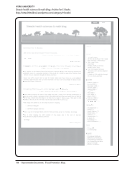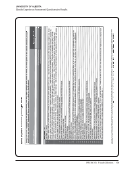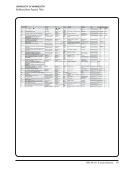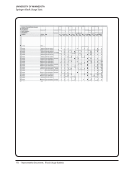40 · Survey Results: Survey Questions And Responses
Download to reader will likely grow in importance in coming years.
E-books are not available for interlibrary loan yet. Perpetual access is an issue. Deletes from the catalogue are
necessary because content is removed from a given platform — we prefer to avoid adds and drops. The content
should be compatible with alternative format readers, e.g. Kurtzweil.
Expected to serve many users.
Few of our e-book purchases are related to consortial purchases. The individual titles we have purchased permit only
one simultaneous user. The aggregator states their research shows there is little need for multiple simultaneous users.
Lacking a policy currently, selection criteria have not been applied consistently.
Persistent links, perpetual access, portability, currency (electronic versions as current as the print version)
Price is a factor, of course. So is demonstrated consistent online access (we have, for example, held up on some deals
because of awkward plug-in software).
Purchase model with small or no ongoing costs.
Reflects need for portability, interoperability and non-proprietary file formats Does not require additional plug-ins, or
reader software.
Subject content &interface.
The cost and the license model are always important criteria.
The DRM restrictions are key if they are set, a la NetLibary, to the least common denominator/ strictest publisher,
there will be a bias against buying on that platform.
The way ILL is permitted is important. Currently ILL is based on the way articles are used, not on monograph type of
use.
We believe heavily in patron-driven rent-to-own or pay-per-view models with automatic purchase options. We like
to achieve $3 to $5 cost-per-use numbers for our e-books, and look for the type of business models and books that
will allow us to hit those targets. Faculty have been using our e-books for reserves and course readings for the last
decade, so a permanent URL that can be posted on a class Website or course management system is important.
We would be more open to a model that allows us to share e-books within a consortium but have not experimented
with that yet. Going forward, though, it will be critical to be able to lend e-books via ILL.
Download to reader will likely grow in importance in coming years.
E-books are not available for interlibrary loan yet. Perpetual access is an issue. Deletes from the catalogue are
necessary because content is removed from a given platform — we prefer to avoid adds and drops. The content
should be compatible with alternative format readers, e.g. Kurtzweil.
Expected to serve many users.
Few of our e-book purchases are related to consortial purchases. The individual titles we have purchased permit only
one simultaneous user. The aggregator states their research shows there is little need for multiple simultaneous users.
Lacking a policy currently, selection criteria have not been applied consistently.
Persistent links, perpetual access, portability, currency (electronic versions as current as the print version)
Price is a factor, of course. So is demonstrated consistent online access (we have, for example, held up on some deals
because of awkward plug-in software).
Purchase model with small or no ongoing costs.
Reflects need for portability, interoperability and non-proprietary file formats Does not require additional plug-ins, or
reader software.
Subject content &interface.
The cost and the license model are always important criteria.
The DRM restrictions are key if they are set, a la NetLibary, to the least common denominator/ strictest publisher,
there will be a bias against buying on that platform.
The way ILL is permitted is important. Currently ILL is based on the way articles are used, not on monograph type of
use.
We believe heavily in patron-driven rent-to-own or pay-per-view models with automatic purchase options. We like
to achieve $3 to $5 cost-per-use numbers for our e-books, and look for the type of business models and books that
will allow us to hit those targets. Faculty have been using our e-books for reserves and course readings for the last
decade, so a permanent URL that can be posted on a class Website or course management system is important.
We would be more open to a model that allows us to share e-books within a consortium but have not experimented
with that yet. Going forward, though, it will be critical to be able to lend e-books via ILL.
























































































































































































